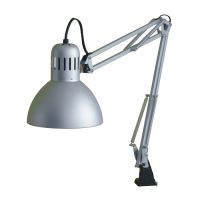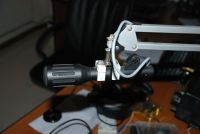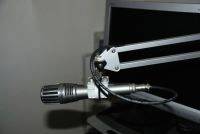Cheap Mike Boom
One of my favourite tasks is looking to other operators' shack layout (specially after a QSO or a listening), searching some good ideas to improve mine: Internet is for sure the best tool to perform those searches!
While surfing the Net, I noticed that many hams use, mainly in fixed station but also during field days, a boom mike, like the ones
used in recording or broadcasting studios. My shacks have been always equipped with tabletop microphones as well as headsets and
footswitch (used in contesting); since I've no experience using such, apparently very popular, devices, I decided to give
them a try.
In my humble opinion, the best audio devices for hams are the ones from Heil Sound: I'm the proud owner of a PROSET with HC-5 which
really sounds good after more than 10 years (by the way, Heil is also selling spare parts - I had to buy some pieces because
I broke my PROSET during an house relocation). Based on such experience, I had a look on
(www.heilsound.com) searching the proper device, but I had to immediatly regret because of prices.
Just to clarify, I think that Mr. Heil's products are really the best in the market, but they were just too expensive for
no more than a try.
The idea
Basically, a mike boom looks like a common reading lamp: so, to solve my problem, I need to buy a cheap table lamp, replace
the lighting part with "something" capable of holding a microphone. Of course, things are not so simple, specially the first part, i.e.
to find a cheap lamp to sacrifice to this experiment.
After some time, I found the answer in my house, looking on my wife's desk: her reading lamp was not only suitable for my project
but was also really really cheap (the manufacturer is a famous shop, based in SM, who sell fornitures in kits): of course I could not
steal my wife's light, so I bought another lamp for 5 euros (nowadays it costs about 7 euros, but it's really workt it).
How I did it
The first step is to remove the light lamp (held by two small bolts) and replaced the electric cable with a shielded one.
The big issue I then faced is finding a way to get the microphone firmly fixed to the boom: I ended up stretching the little metal plate
(which originally hold the lamp) and placing over some clips used in electrical cabling (of course you have to find the proper clip size).
Clips shouls easily sustain the mic's weight but to be sure I also used a little plastic belt.
Photos display my two booms: the right one is used for an ICOM SM20 ( I remove the mic from the base and replaced the original cable),
directly held by clips and belts. The left one is for a Kenwood MC60, where I used a small plastic tube (again, this kind of
pipes is normally used in electrical cabling) to keep the mic since its size is not the same along his lenght.
For the PTT part, I used two footswitches: the old one is a professional (and expensive!) footswitch normally used in industrial machines
(many hams in my club have those switches) while the second is a simpler switch which was given to me as present by another ham
(to be honest, this second one is not so beautiful as the first unit but it for sure works flawlessy for the backup transceiver).
The result
I've those unit for more than one year and I must admit they boom mikes are really more confortable than desktop mics: and
they cost me no more than 10 euros each! If your plan is to do HIFI SSB, then this solution is not optimal because mics are not
equipped with any kind of shock absorber, thus they capture any noise made on the table where they are fixed. Otherwise,
if you use them for normal QSO as well as DX this solution seems pretty adequate.
Happy building...



